
The euphonium is a medium-sized, 3 or 4-valve, often compensating, conical-bore, tenor-voiced brass instrument that derives its name from the Ancient Greek word εὔφωνος euphōnos, meaning "well-sounding" or "sweet-voiced". The euphonium is a valved instrument. Nearly all current models have piston valves, though some models with rotary valves do exist.
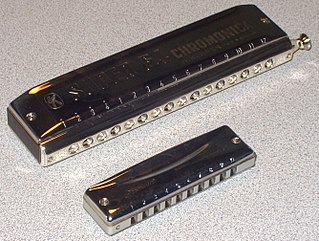
The harmonica, also known as a French harp or mouth organ, is a free reed wind instrument used worldwide in many musical genres, notably in blues, American folk music, classical music, jazz, country, and rock. The many types of harmonica include diatonic, chromatic, tremolo, octave, orchestral, and bass versions. A harmonica is played by using the mouth to direct air into or out of one holes along a mouthpiece. Behind each hole is a chamber containing at least one reed. The most common is the diatonic Richter-tuned with ten air passages and twenty reeds, often called the blues harp. A harmonica reed is a flat, elongated spring typically made of brass, stainless steel, or bronze, which is secured at one end over a slot that serves as an airway. When the free end is made to vibrate by the player's air, it alternately blocks and unblocks the airway to produce sound.

An autoharp or chord zither is a string instrument belonging to the zither family. It uses a series of bars individually configured to mute all strings other than those needed for the intended chord. The term autoharp was once a trademark of the Oscar Schmidt company, but has become a generic designation for all such instruments, regardless of manufacturer.
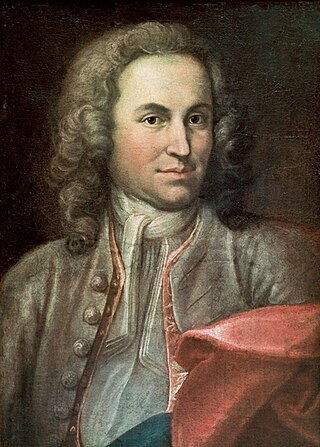
Nach dir, Herr, verlanget mich, BWV 150, is an early church cantata by Johann Sebastian Bach composed for an unknown occasion. It is unique among Bach's cantatas in its sparse orchestration and in the independence and prominence of the chorus, which is featured in four out of seven movements. The text alternates verses from Psalm 25 and poetry by an unknown librettist. Bach scored the work for four vocal parts and a small Baroque instrumental ensemble of two violins, bassoon and basso continuo.

George Allen Russell was an American jazz pianist, composer, arranger and theorist. He is considered one of the first jazz musicians to contribute to general music theory with a theory of harmony based on jazz rather than European music, in his book Lydian Chromatic Concept of Tonal Organization (1953).

The Richter-tuned harmonica, 10-hole harmonica or blues harp, is the most widely known type of harmonica. It is a variety of diatonic harmonica, with ten holes which offer the player 19 notes in a three-octave range.
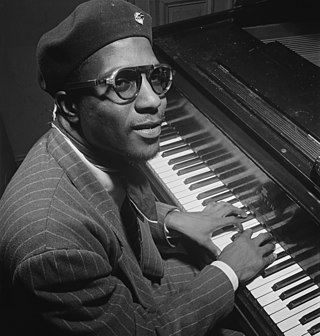
Jazz piano is a collective term for the techniques pianists use when playing jazz. The piano has been an integral part of the jazz idiom since its inception, in both solo and ensemble settings. Its role is multifaceted due largely to the instrument's combined melodic and harmonic capabilities. For this reason it is an important tool of jazz musicians and composers for teaching and learning jazz theory and set arrangement, regardless of their main instrument. By extension the phrase 'jazz piano' can refer to similar techniques on any keyboard instrument.
Joel Andrew Quarrington is a Canadian double bass player, soloist and teacher. He is the former Principal Double Bass of the London Symphony Orchestra.

Harry Sparnaay was a noted Dutch bass clarinetist, composer, and teacher.
A double bass concerto is a notated musical composition, usually in three parts or movements, for a solo double bass accompanied by an orchestra. Bass concertos typically require an advanced level of technique, as they often use very high-register passages, harmonics, challenging scale and arpeggio lines and difficult bowing techniques. Music students typically play bass concerti with the orchestral part played by a pianist who reads from an orchestral reduction.
Esko Laine is a professor of music at Hochschule für Musik "Hanns Eisler" in Berlin and principal double bassist for the Berlin Philharmonic.
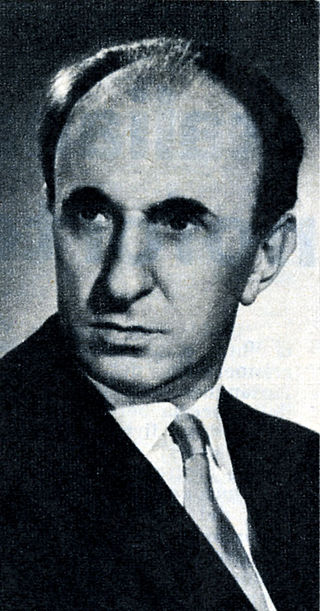
Virgilio Mortari was an Italian composer and teacher.
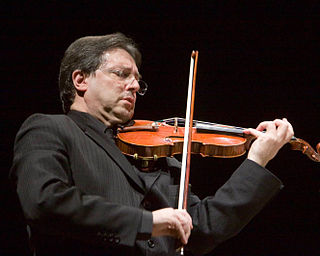
Franco Mezzena born 4 November 1953 in Trento, northern Italy, is an Italian violin virtuoso. He studied ten years with Salvatore Accardo.

A free-bass system is a system of left-hand bass buttons on an accordion, arranged to give the performer greater ability to play melodies with the left-hand and form one's own chords. The left-hand buttonboard consists of single-note buttons with a range of three octaves or more, in contrast to the standard Stradella bass system, which offers a shorter range of single bass notes, plus preset major, minor, dominant seventh, and diminished chord buttons. The term "free-bass system" refers to various left-hand manual systems that provide this functionality: The Stradella system does not have buttons for different octaves of the bass notes, which limits the types of melodies and basslines that can be performed with the left hand.

Rocco Filippini was a Swiss classical cellist.

Jazz flute is the use of the flute in jazz music. While flutes were sometimes played in ragtime and early jazz ensembles, the flute became established as a jazz instrument in the 1950s. It is now widely used in ensembles and by soloists. The modern Boehm system transverse concert flute is commonly used in jazz playing; other members of the same family are used, such as the alto flute in G. Ethnic and other flutes, such as bamboo flutes, have also been used in jazz.
Violin Concerto No. 4 in D minor, MS 60, is a concerto composed by Niccolò Paganini in the fall of 1829.
Franco Luciani is an Argentine musician and composer who plays harmonica.
Petracchi is an Italian surname. Notable people with the surname include:













